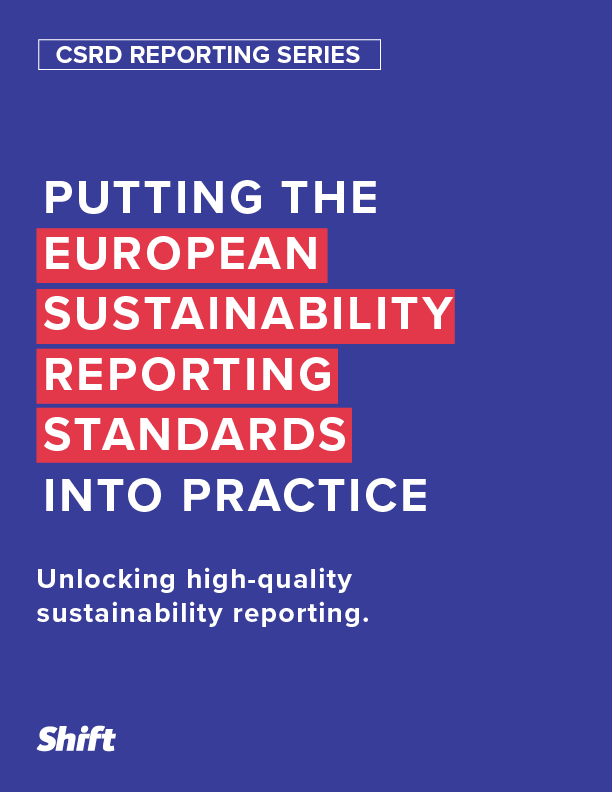Shift’s Guidance on the European Sustainability Reporting Standards
Primers for practitioners
7 resources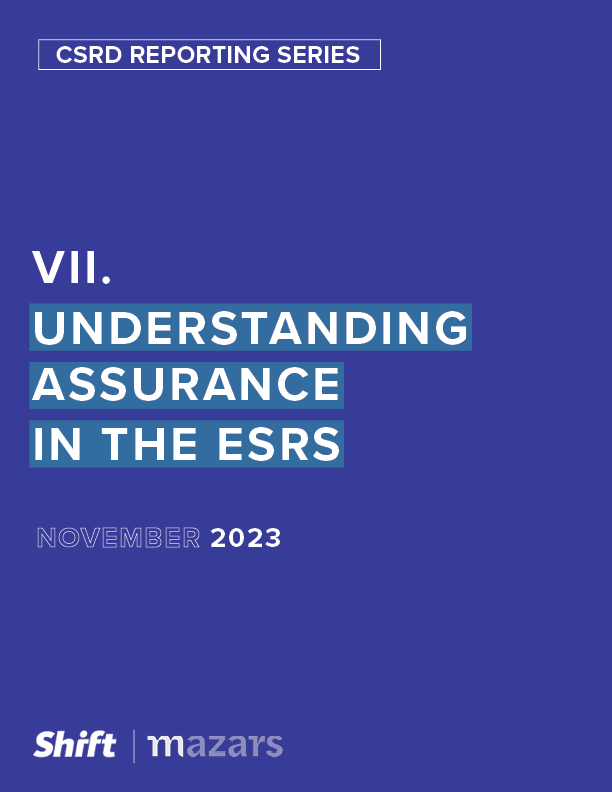
Understanding Assurance in the ESRS
Part 7
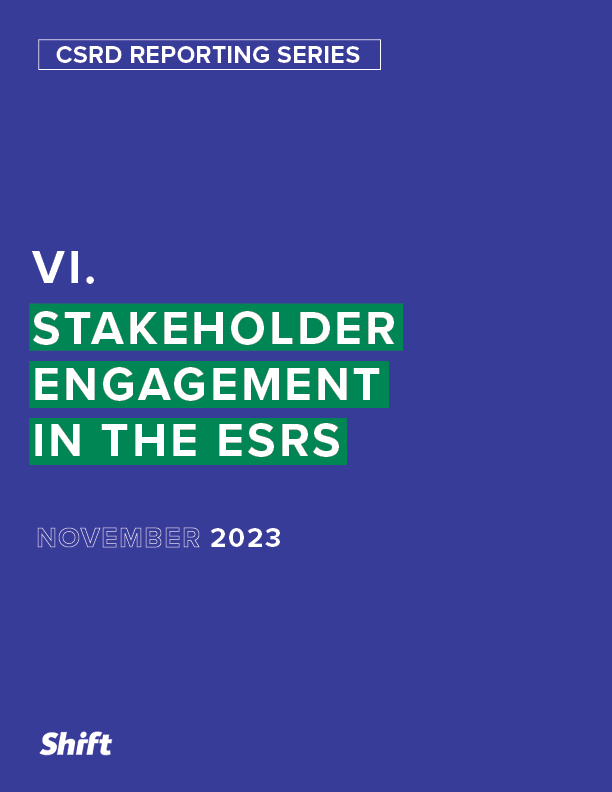
Stakeholder Engagement in the ESRS
Part 6
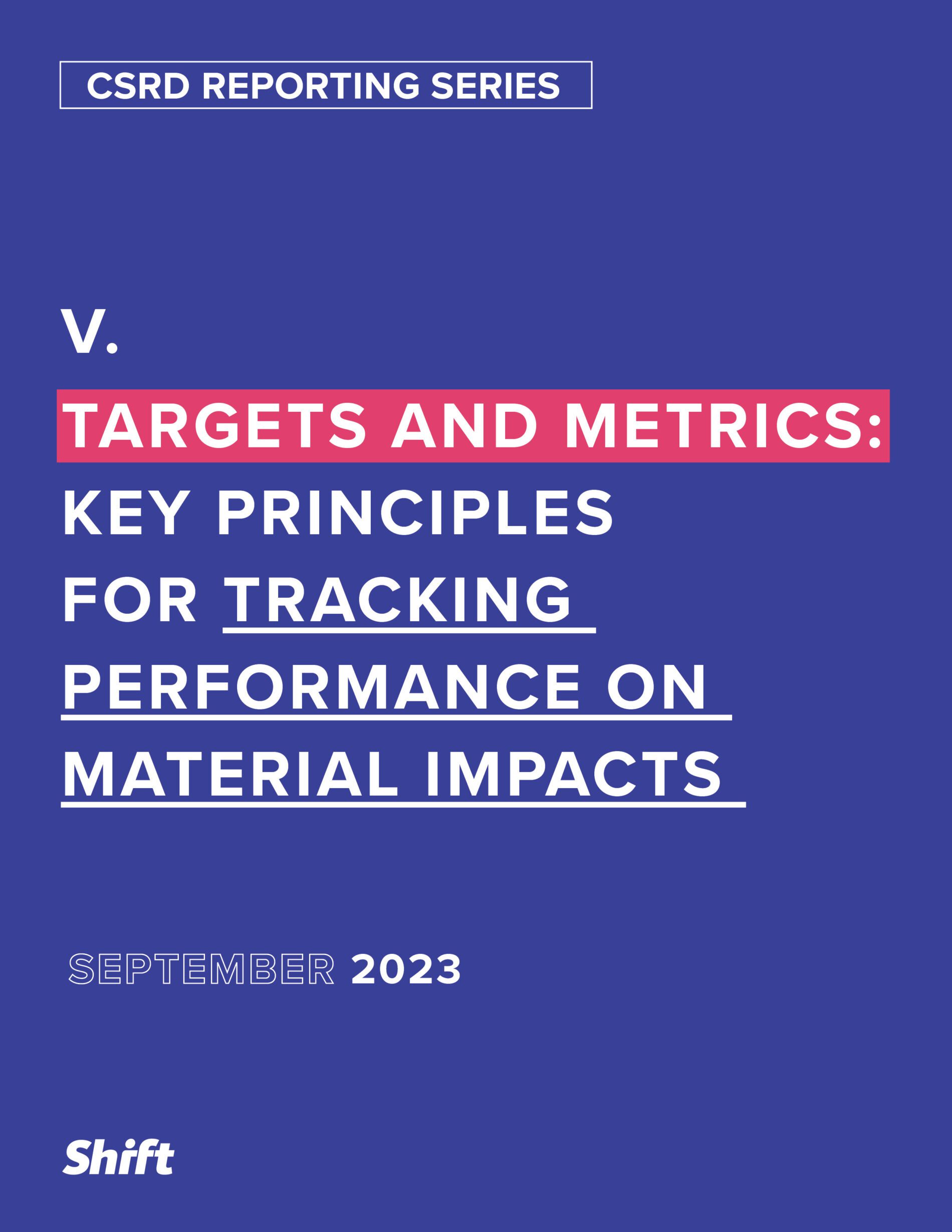
Targets and Metrics: Key Principles for Tracking Performance on Material Impacts
Part 5
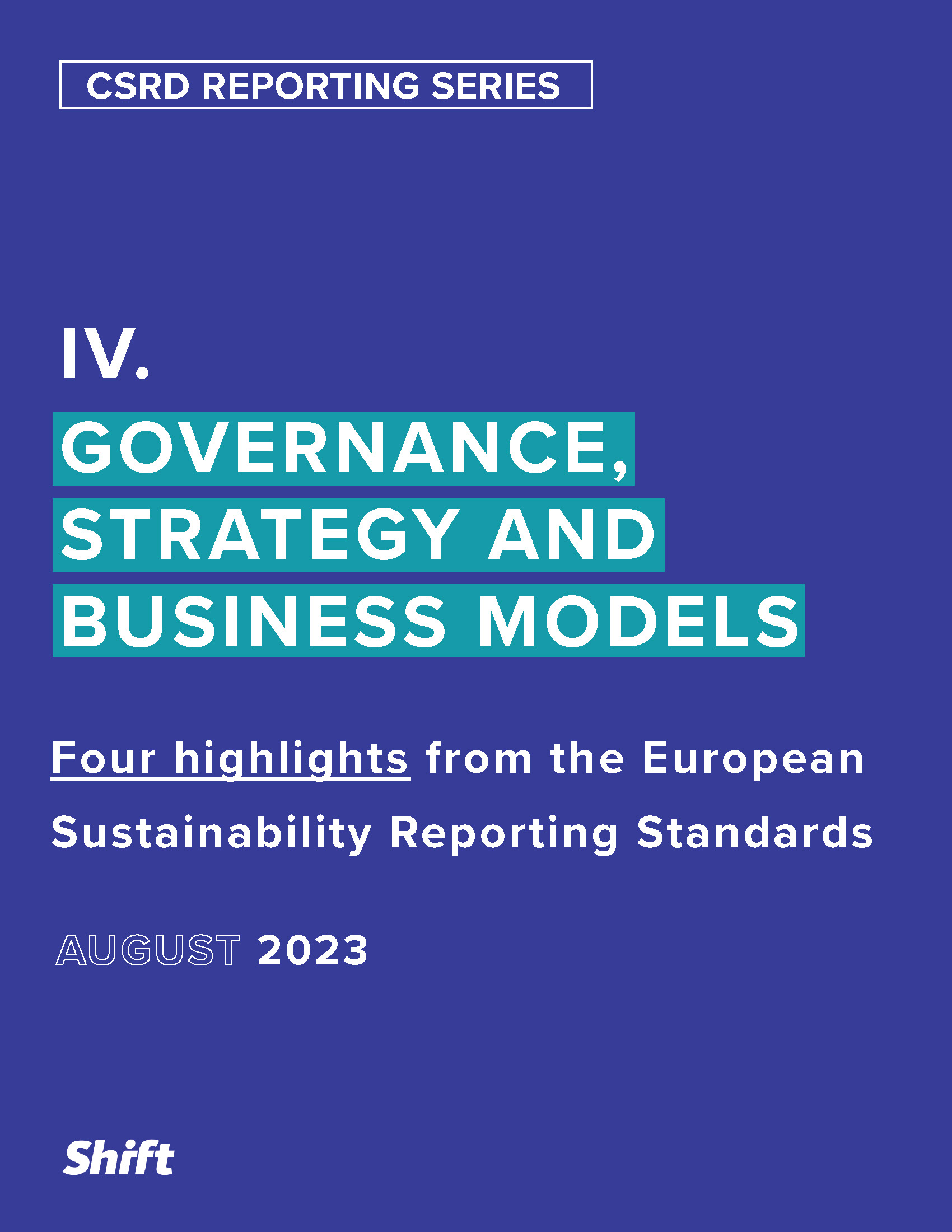
Governance, Strategy and Business Models: four highlights from the European Sustainability Reporting Standards
Part 4
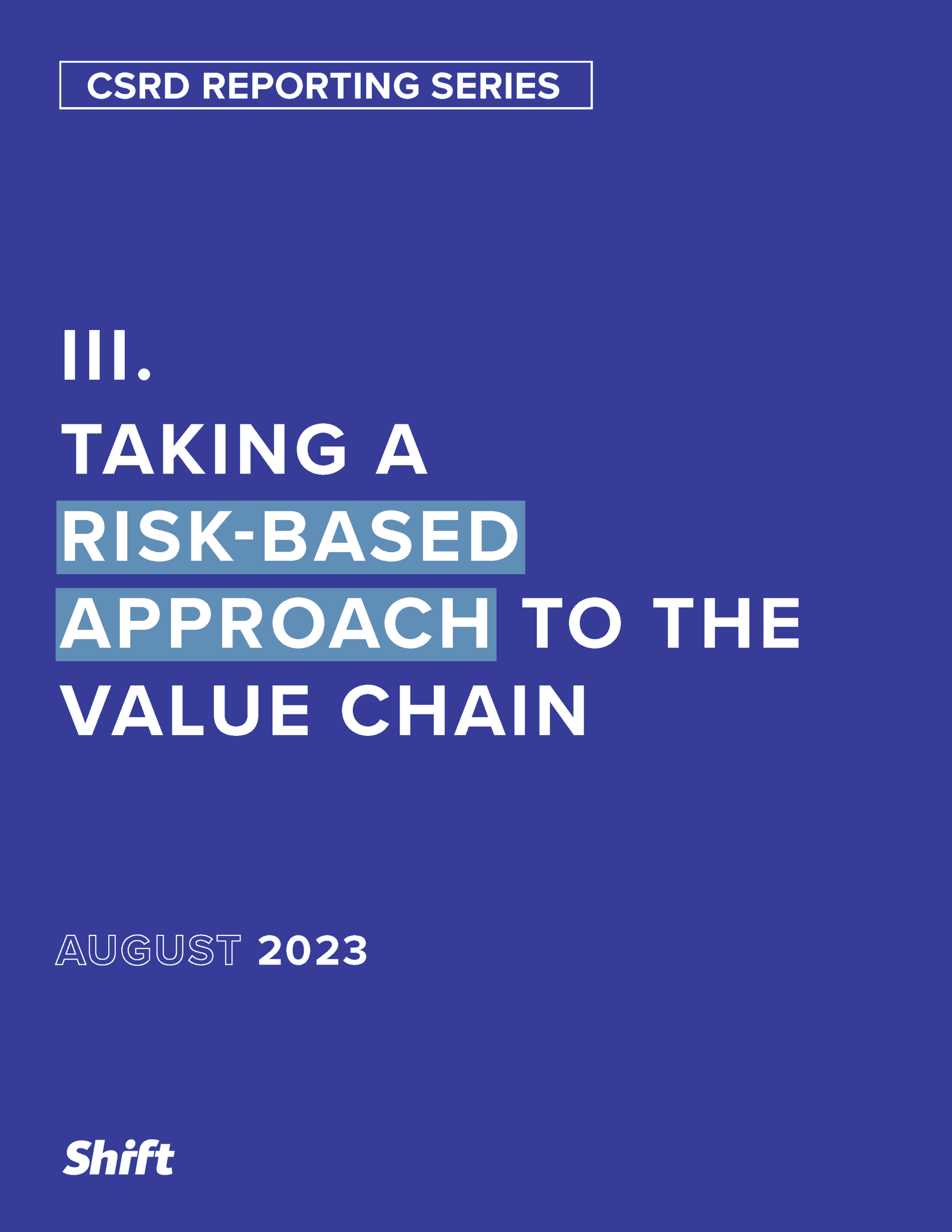
Taking a Risk-Based Approach to the Value Chain
Part 3
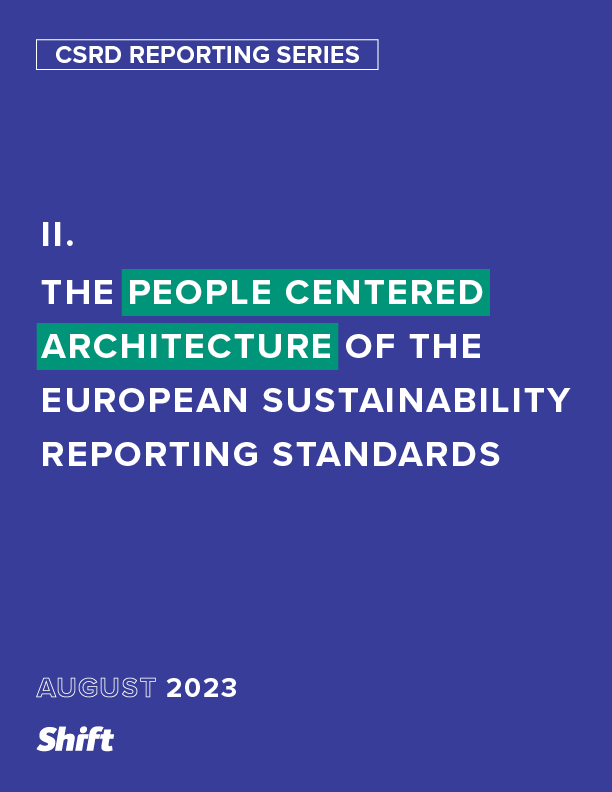
The People Centered Architecture of the European Sustainability Reporting Standards
Part 2
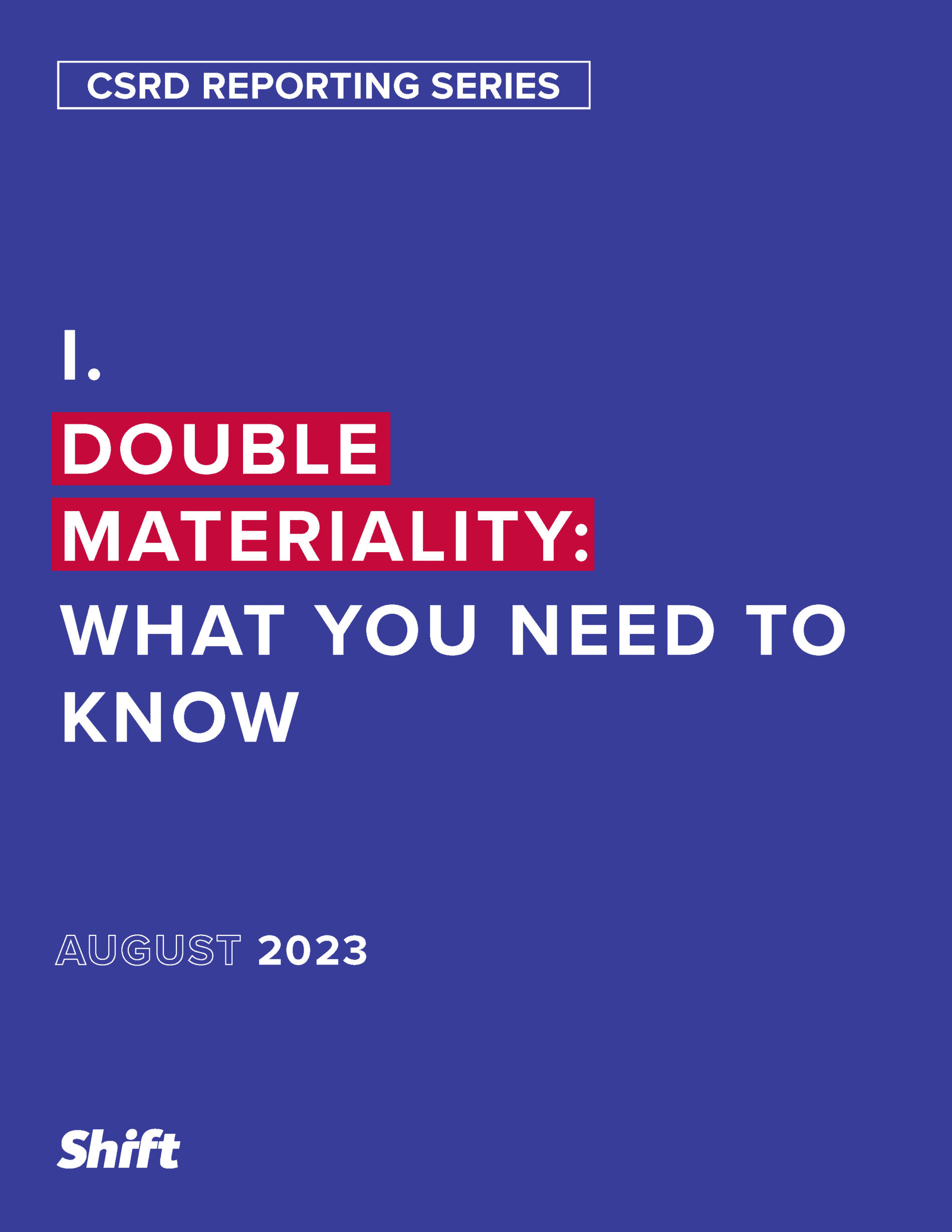
Double Materiality: What you need to know
Part 1
Shift’s series of primers on the European Sustainability Reporting Standards (ESRS) is for everyone and anyone tasked with putting the standards into practice – whether you’re working within a company, or advising one. The Standards are designed to ensure greater rigor, completeness and comparability in companies’ reporting on their sustainability performance across environmental (including climate), social (primarily human rights) and governance issues, in line with the EU’s Corporate Sustainability Reporting Directive (CSRD). We hope this series supports the coherent interpretation and robust implementation of the standards that will unlock high-quality reporting on sustainability.
As a ‘co-construction’ partner in the early development of the ESRS, and with our Director of Business Engagement, David Vermijs, sitting on the Sustainability Reporting Board (EFRAG) that guided the process, we are glad to be able to help demystify the standards for practitioners.
The need for guidance
The ESRS are set to apply to more than 50,000 companies in the EU and at least 10,000 companies outside. To say the advent of the standards has generated a flurry of activity would be an understatement; companies are now bringing together parts of their organizations that rarely met before – finance and internal audit, compliance and legal, environmental teams and human rights specialists. There are questions about who should lead and whether and how these different experts might work together to apply the standards. And many companies are spending significant amounts of money on hiring consultants to guide them through the process.
So it’s understandable that we’re already seeing a proliferation of interpretations of the standards. The ESRS are hardly drafted in the most accessible terms – indeed, it seems to be the fate of many reporting (and other) standards, to be unhelpfully technical and complex in ways that risk undermining their actual intent.
In addition, consultants are often inclined to interpret standards in ways that best suit the methodologies they are used to applying with their clients. Selective interpretations can come into play as part of a desire to fit these advisory engagements into ‘business as usual’. Indeed, there are cases where internal company experts familiar with key aspects of the ESRS have had to correct their consultants on what they know to be faulty advice. But many more companies lack the in-house expertise to tell the difference.
Clarity is greatly needed. The European Financial Reporting Advisory Group (EFRAG), which was responsible for drafting the standards, will be developing some key guidance over the coming weeks and months; Shift team members David Vermijs and Michelle Langlois will be supporting this process, which will hopefully go some way to addressing gaps in understanding and preventing misinterpretation.
In the meantime, we hope this series of primers will help to answer some of the most frequently asked questions we hear on key aspects of the standards, with a particular focus on social issues and their connections with international standards on human rights due diligence. The series will cover: “double materiality” – and the links between impact materiality and “salient human rights issues”; the novel people-centered architecture of the Social standard; the risk-based approach to identifying material impacts in the “value chain”; and much more.
Bridging the gap between action and reporting
Why are we doing this? Because interpretation matters. It is no accident that the ESRS align closely with the UN Guiding Principles on Business and Human Rights and the OECD Guidelines for Multinational Enterprises – the international standards of conduct on corporate respect for human rights. This ensures that reporting requirements tally with international expectations of how companies identify and address risks to people in their operations and value chains.
Too often, that connection between action and reporting on sustainability has been tenuous – whether that’s because non-financial reporting has been seen by companies as a PR side-show; or because the data demanded of companies has failed to either reflect or support good management of sustainability risks and impacts.
Sustainability reporting should be a natural extension of action – to ensure the authenticity of insights provided to shareholders and other stakeholders, and to ensure that the data being gathered is of value for internal managers. It is this relationship that turns the costs of reporting into an investment in effective risk management. If a hundred interpretations of the ESRS now emerge, that prize will be lost.
The coming months and years will be a litmus test for whether the ESRS can re-solidify this relationship between action and reporting on sustainability matters, including on material social issues that have too long been ignored or downplayed. If not, this pioneering European initiative will in good part have failed. Now is the time to make sure that it succeeds. We hope that this series of primers can help you play a part in helping ensure that it does.
Indigenous Rights and Financial Institutions: Free, Prior and Informed Consent, Just Transition and Emerging Practice
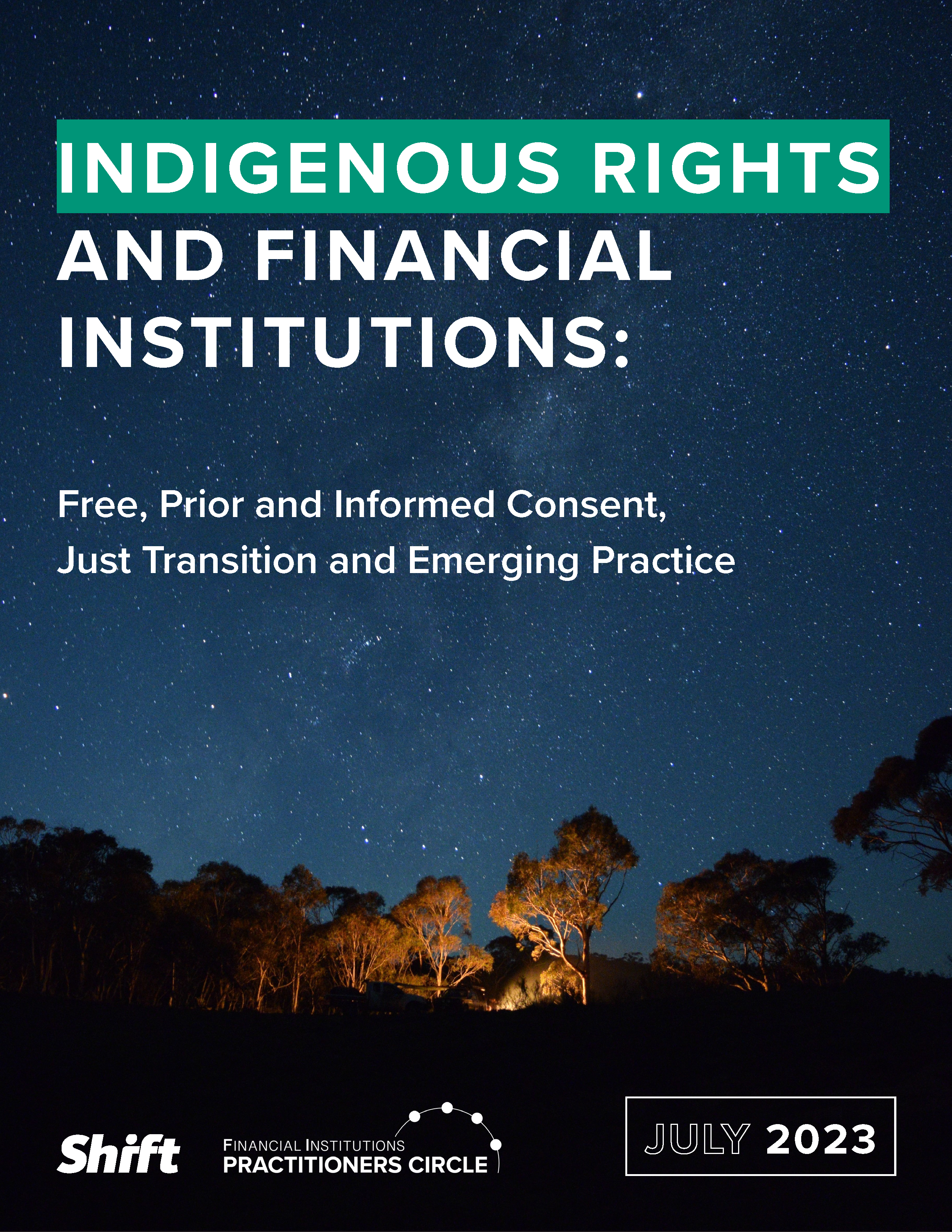
Companies, civil society and the finance sector are paying increasing attention to Indigenous Peoples rights and expertise, which are critical in the context of our most pressing global agenda items: climate change and biodiversity loss. This is not least because much of the world’s biodiversity, and many of the natural resources needed for the energy transition, are located on indigenous territories. However, recent events, from the Dakota Access Pipeline protests to the Juukan Gorge disaster, demonstrate that prevailing approaches to identifying and managing the impacts of business on Indigenous Peoples are falling short. That is, businesses are failing to meet their responsibility to respect indigenous rights under international standards.
Also Read
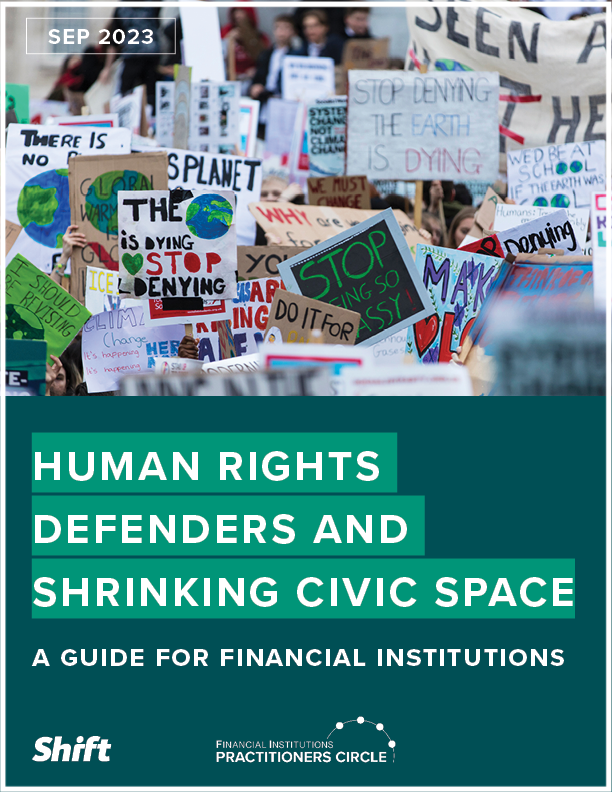
September 2023 |
Human Rights Defenders and Shrinking Civic Space: A Guide for Financial Institutions
Read
Free, Prior and Informed Consent
Financial institutions (FIs) are critical players in the value chains associated with impacts – both positive and negative – on Indigenous People. With the rapid scale-up of financing for transition minerals and growing awareness of the need for nature-based solutions, FIs must ensure both they and their clients understand and respect Indigenous People’s rights – which includes ensuring that clients obtain “free, prior and informed consent” (FPIC) when developing projects on indigenous lands. Without FPIC, project owners and their financiers face the prospect of conflict, reputational damage, lengthy delays and project cancellations, as well as a failure to meet international standards.
Overcoming Key Challenges to FPIC
In December 2022, Shift held a Financial Institutions Practitioners Circle (FIs Circle) on Indigenous Peoples rights. Two expert contributors, Lloyd Lipsett and Mark Podlasly, shared their insights from decades of experience working with Indigenous Peoples interfacing with development on their lands. Together, we fielded some of the burning questions financial institutions are grappling with as they finance clients with projects or value chains connected to indigenous territories:
- What do FIs need to know when there are differing views on whether a community is “indigenous”?
- How can FIs determine what “good” Free, Prior and Informed Consent (FPIC) processes look like?
- What steps should FIs take when supplied with limited or poor-quality information on respect for indigenous rights by their clients?
- How can FIs spot – and address – power imbalances between clients and Indigenous People?
This paper captures key takeaways from the session, focusing on the responsibility to obtain and maintain FPIC. This focus reflects the importance of FPIC as a process to safeguard Indigenous Peoples rights to self-determination, to participation, and to their lands, territories and resources.
Designing an EU Due Diligence Duty that Delivers Better Outcomes
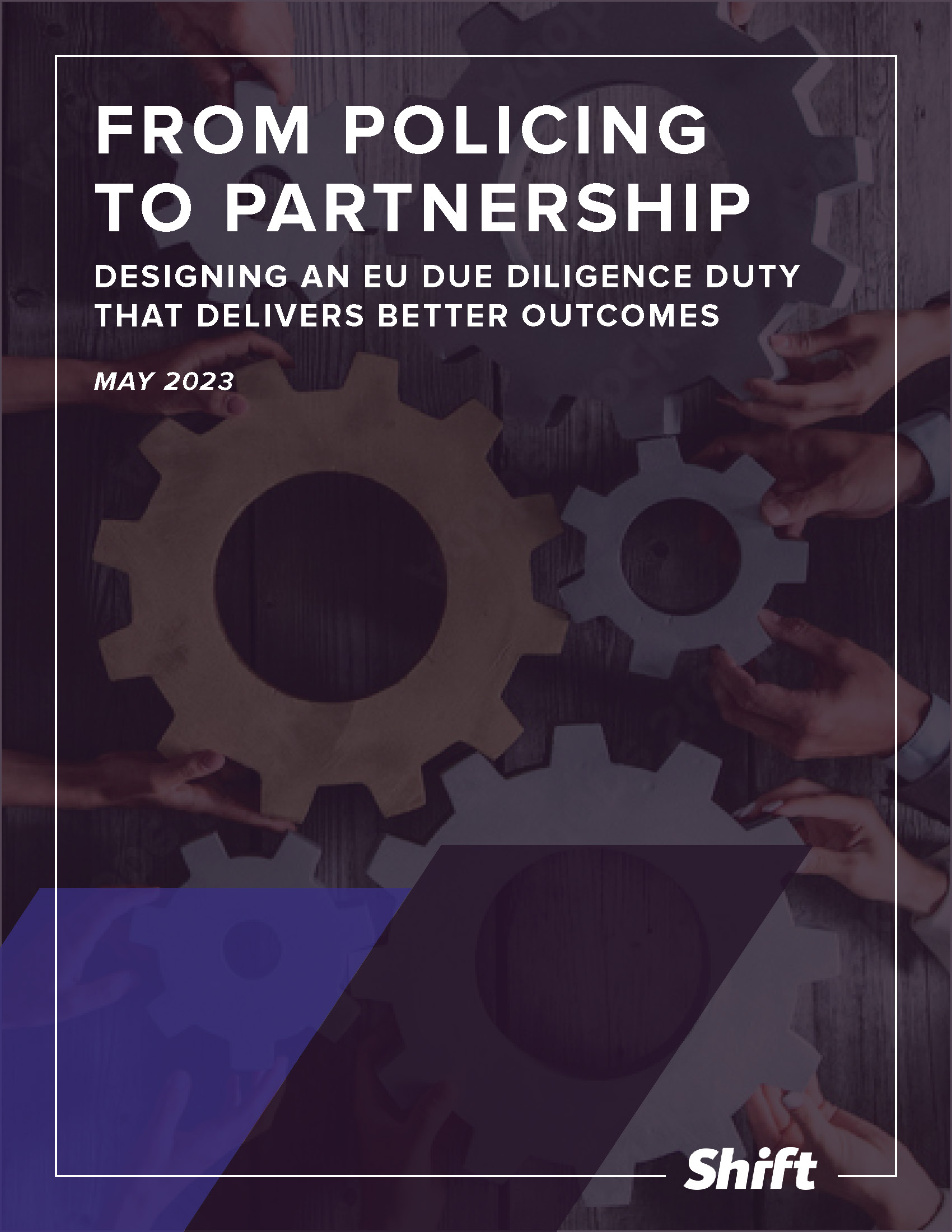
What is the CS3D?
Starting in 2022, the European Union has been negotiating a draft Directive on Corporate Sustainability Due Diligence (CS3D), with discussions on a final law expected to begin by mid-2023. The draft Directive aims to ensure companies active in the single European market contribute to sustainable development by preventing and addressing negative human rights and environmental impacts.
How can we ensure the directive delivers for people and planet?
In our latest report, From Policing to Partnership: Designing an EU Due Diligence Duty that Delivers Better Outcomes, we set out clear recommendations to better align the core content of the duty to do due diligence in the draft Directive with the authoritative international standards for sustainability due diligence.
While the new duty will only apply to certain companies headquartered or operating in the single market, their business partners and other companies in key sourcing and production markets outside the EU will have an essential role to play. Our report is based on interviews with businesses and other stakeholders in Bangladesh, Kenya, Tanzania, and Thailand on the challenges and opportunities facing local companies in meeting their EU business partners’ human rights and environmental expectations, and in preventing and addressing human rights impacts in their operations.
The report looks at some of the current dynamics between EU companies and their non-EU business partners in managing human rights risks, and explores the opportunity the Directive presents to shift from a top-down ‘policing’ approach to one based on collaboration and mutual responsibility, in line with the international standards. It aims to bring the perspectives of companies in key markets into the current debate to provide vital insights into the kinds of practices and behaviors that should be incentivized in the new Directive – and those that should be discouraged – if we truly want it to deliver better outcomes for people and planet.
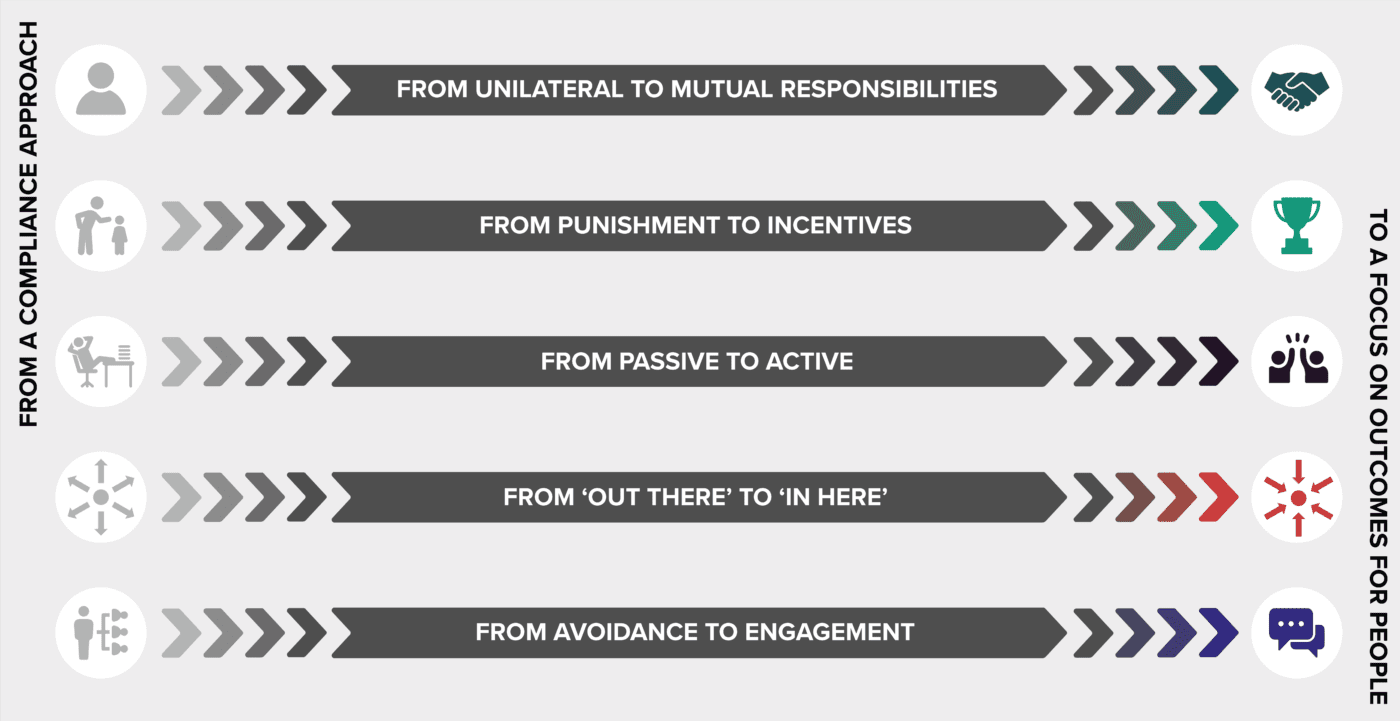
This report is divided into two main sections:
Section B, What did we hear? provides an overview of current behaviors and practices that are often not conducive to meaningful human rights due diligence.
Section C contains two parts:
- What is different about the international standards? benchmarks some of the problematic practices encountered against the international due diligence standards. It highlights what would signal more meaningful due diligence approaches, as compared to those that currently seem to dominate many of the relationships between EU companies and their business partners.
- What is the opportunity? underscores the potential for the CS3D to define a carefully crafted due diligence duty that incentivizes a shift towards practices that are more aligned with meaningful due diligence.
This research is part of a project funded by the Ministry for Foreign Affairs of Sweden.
Submission to the International Finance Corporation/Multilateral Investment Guarantee Agency (IFC/MIGA) Consultation on the proposed “Approach to Remedial Action”

At Shift, we have worked for several years with a wide range of financial institutions and their stakeholders seeking to embed the UN Guiding Principles on Business and Human Rights (UNGPs) into their practice, as well as supporting the integration of the UNGPs into the work and tools of various financial industry associations and initiatives. One of our areas of focus has been defining and operationalizing the concept of the ‘remedy ecosystem’ and the important role financial institutions can play in enabling remedy, including in the context of the innovative Dutch Banking Sector Agreement.
From March through April 2022, Shift supported the initial conversations of the IFC/MIGA interdepartmental Working Group on IFC/MIGA’s approach to remedial action by providing initial scoping and research on remedy as reflected in the UNGPs. IFC/MIGA subsequently carried out further analysis and then developed and published a proposed “Approach to Remedial Action” for public consultation. We are pleased to make this submission to that consultation.
We recognize that this is an extremely important topic for IFC/MIGA to be tackling in terms of its potential to deliver meaningful outcomes for people in connection with IFC/MIGA’s own investments and also in the signals that such an approach can send to other financial institutions, particularly national and regional development finance institutions.
IFC/MIGA’s proposed “Approach to Remedial Action” (the Approach) references extensively the concepts of the remedy ecosystem and enabling remedy. On the positive side, we note with appreciation that the Approach considers “prospective and anticipatory measures” throughout the project cycle that could lessen the need for and/or increase preparedness for remedy. However, the Approach is grounded in an assumption that IFC/MIGA’s involvement in remedy will typically take, absent “exceptional circumstances”, the primary form of “facilitating or supporting” its clients’ provision of remedy.
In this submission, we provide some background on the development of these concepts, grounded in the international standards on human rights due diligence (the UNGPs and the OECD Guidelines for Multinational Enterprises), and highlight examples of application of these concepts by financial institutions that we would encourage the IFC/MIGA to consider further. Both the Approach and the External Review reference these authoritative frameworks; moreover, a growing number of bilateral development finance institutions (DFIs) have made commitments and advancements in practice with reference to these standards over the last decade. They are increasingly being incorporated, in whole or in part, into existing or emerging regulations and legislation governing responsible business conduct. Most pertinently, the concepts of the remedy ecosystem and enabling remedy emerged from processes that took these standards as a core reference point.
This submission covers:
- The Centrality of the Connection to Harm Analysis to Concepts of Enabling Remedy
- The Remedy Ecosystem and Enabling Remedy
- The Relevance of Proximity to Harm?
We hope that the IFC/MIGA will draw on this, and other feedback, to reorient the core elements of the Approach to align more fully with the existing International Standards and developing practice among other financial institutions.
Climate Change and Human Rights: Avoiding pitfalls for financial institutions
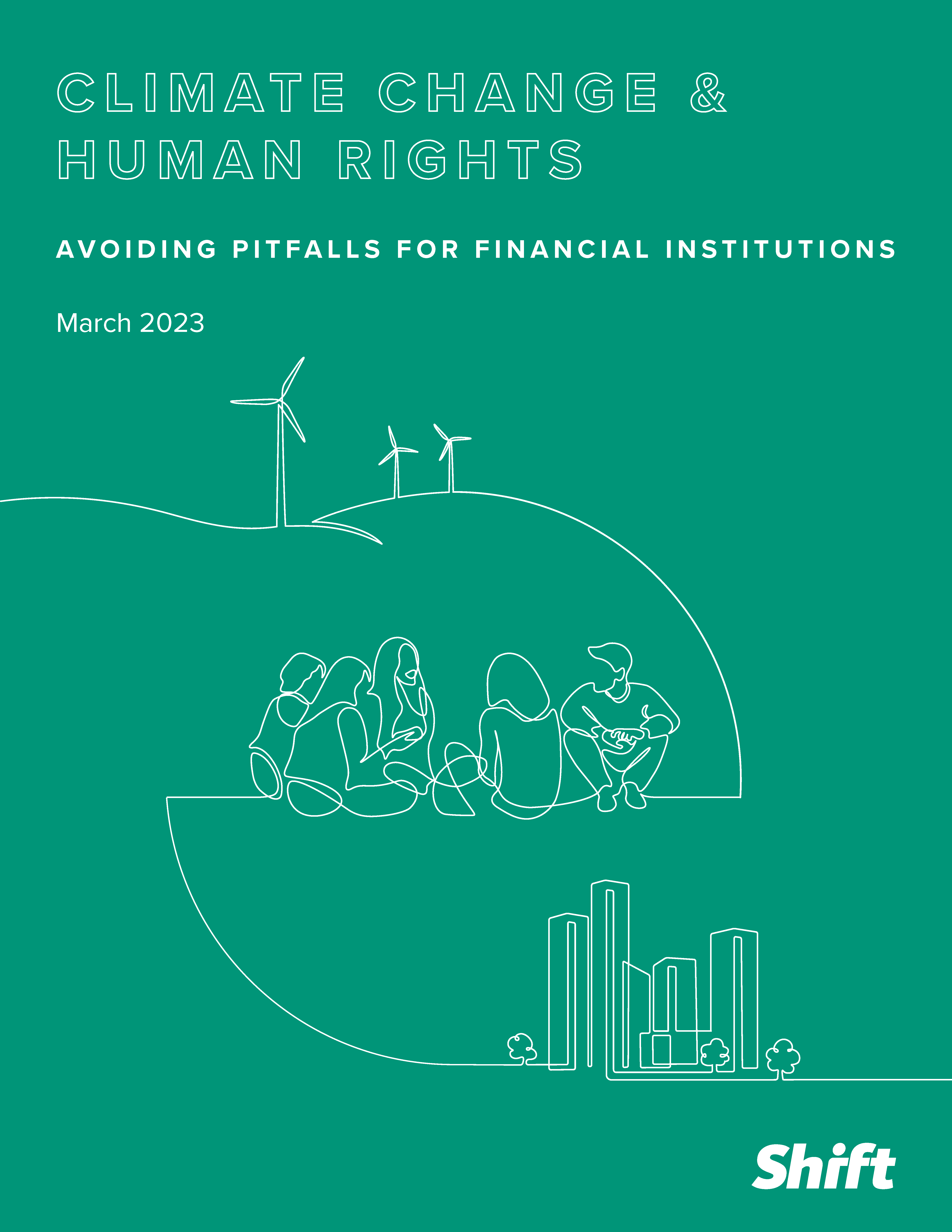
Also Read
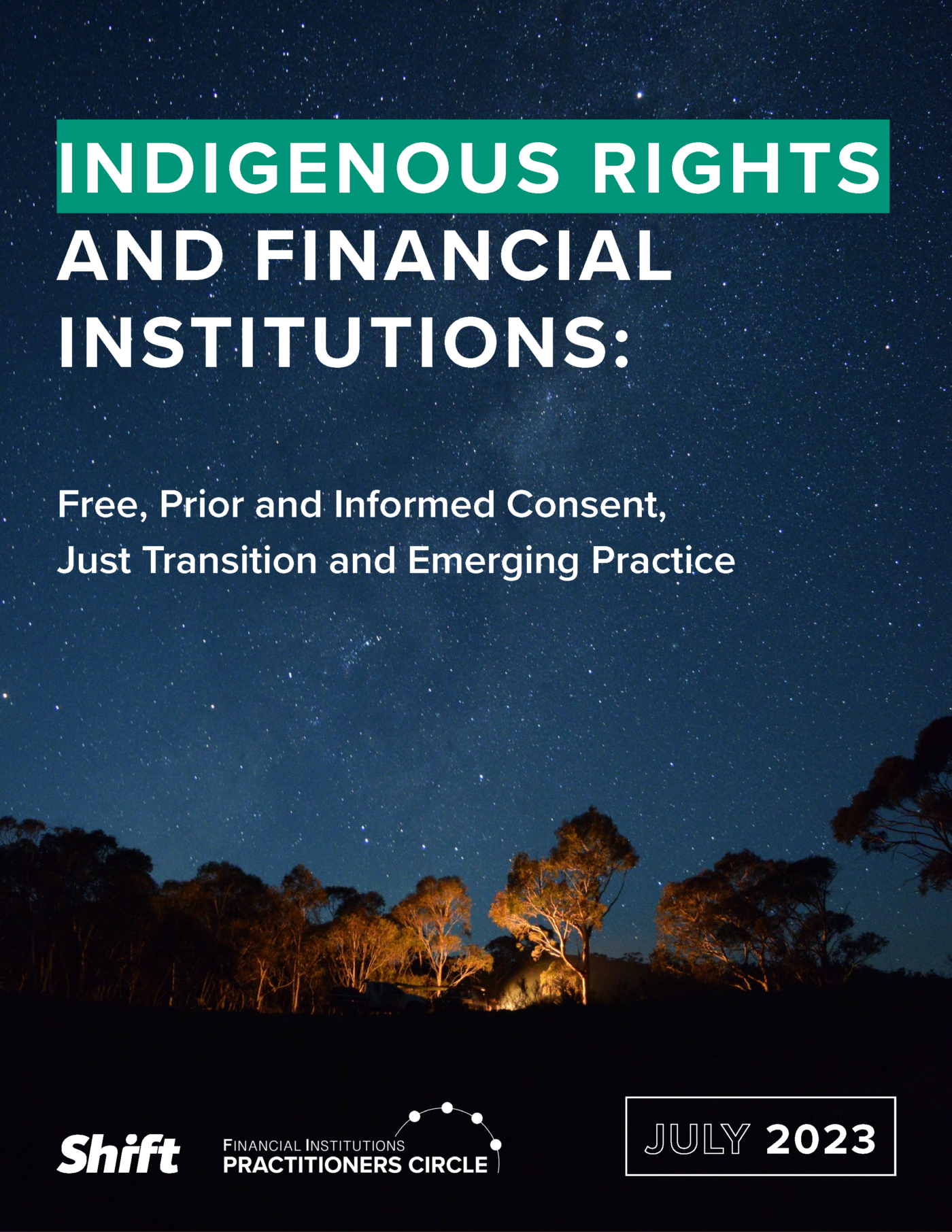
July 2023 |
Indigenous Rights and Financial Institutions: Free, Prior and Informed Consent, Just Transition and Emerging Practice
ReadThis paper explores the nexus between climate change strategy and action by financial institutions (FIs) and the responsibility to respect human rights in accordance with the UN Guiding Principles on Business and Human Rights (UNGPs).
It discusses a series of pitfalls for financial institutions to avoid as they operationalize climate-related commitments and explore the social (“S”) dimensions of the challenges and opportunities presented by the activities of portfolio companies. It explores how the human rights lens of the UNGPs – complemented by over a decade of practice since their endorsement – can inform efforts to ensure transition and adaptation efforts respect peoples’ dignity.
The paper is a companion piece to Shift’s report: Climate Action and Human Rights: How the UNGPs can help companies respect human rights when responding to climate change. It benefited from discussions between banks and ECAs in Shift’s Financial Institutions Practitioners Circle.
Climate Action and Human Rights: How the UN Guiding Principles can help companies respect human rights when responding to climate change
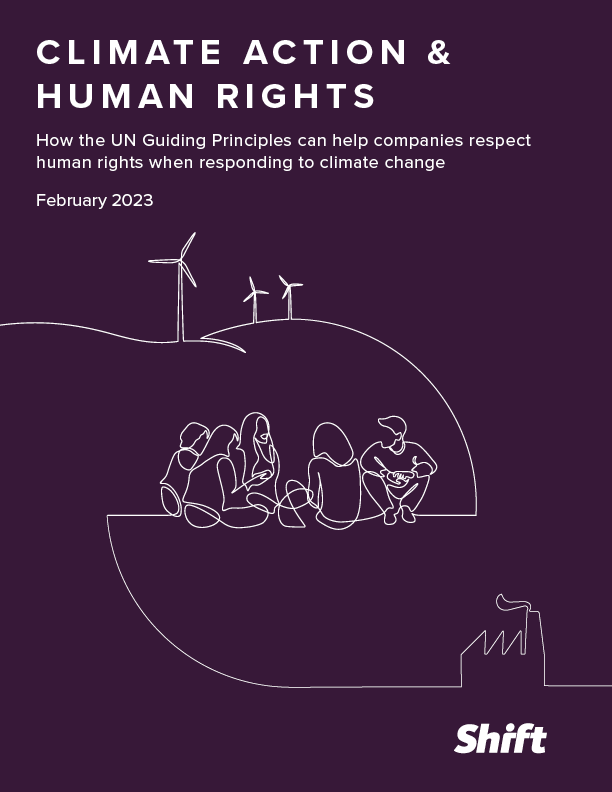
Climate Change Background
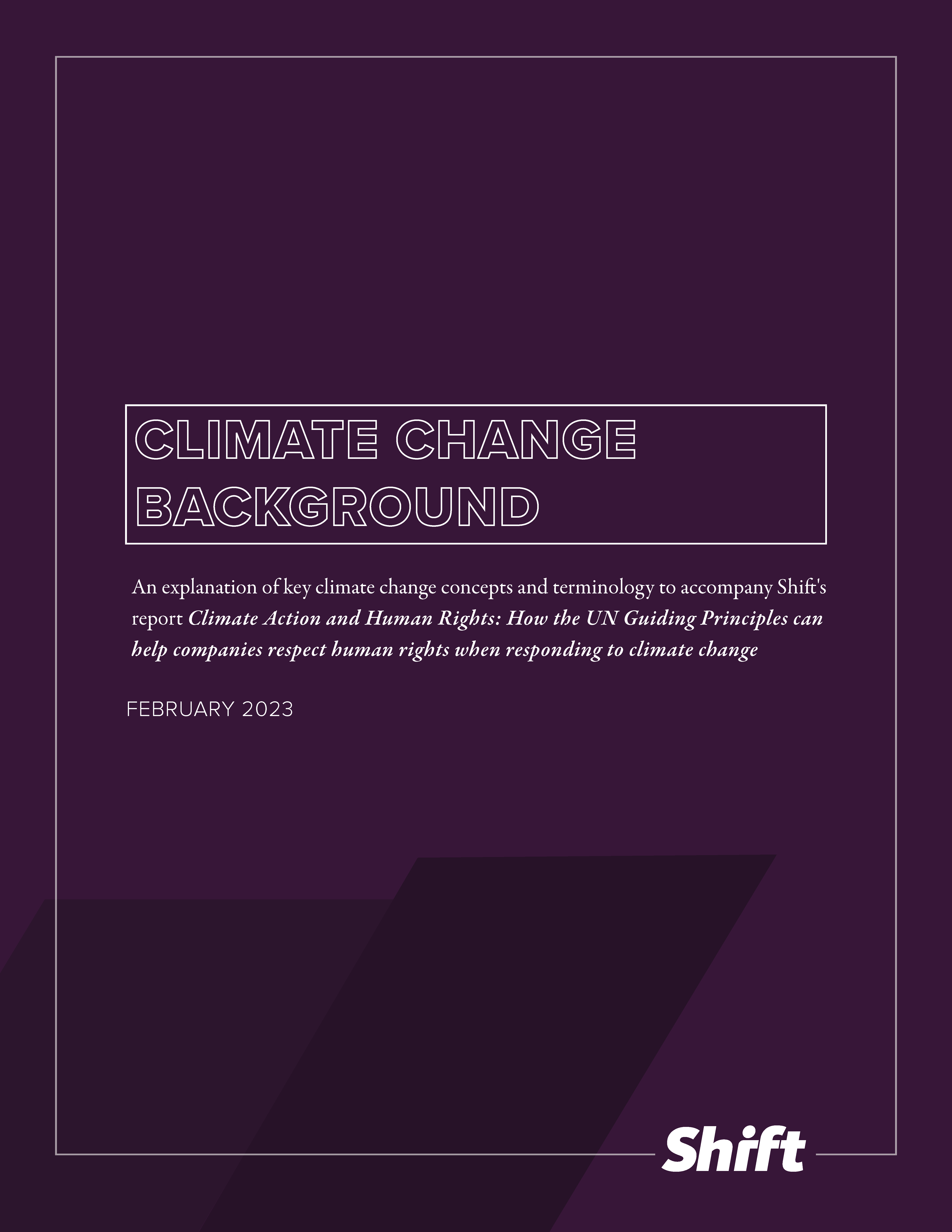
This document is a non-technical introduction to some key climate change concepts for readers who are less familiar with climate change. It explains how climate change could affect businesses and is designed to accompany Shift’s report Climate Action and Human Rights: How the UN Guiding Principles can help companies respect human rights when responding to climate change.
- Part 1 provides an overview of the causes and main drivers of climate change, explains why the 1.5°C and 2°C targets are important and why limiting climate change cannot be postponed.
- Part 2 explains the relevance of the Paris Accord targets and highlights the scenarios used in the most recent IPCC reports and their relevance.
- Part 3 explains the impact that climate change may have on businesses, the concept and relevance of net zero targets and greenhouse gas accounting.
What data do investors need to manage human rights risks?
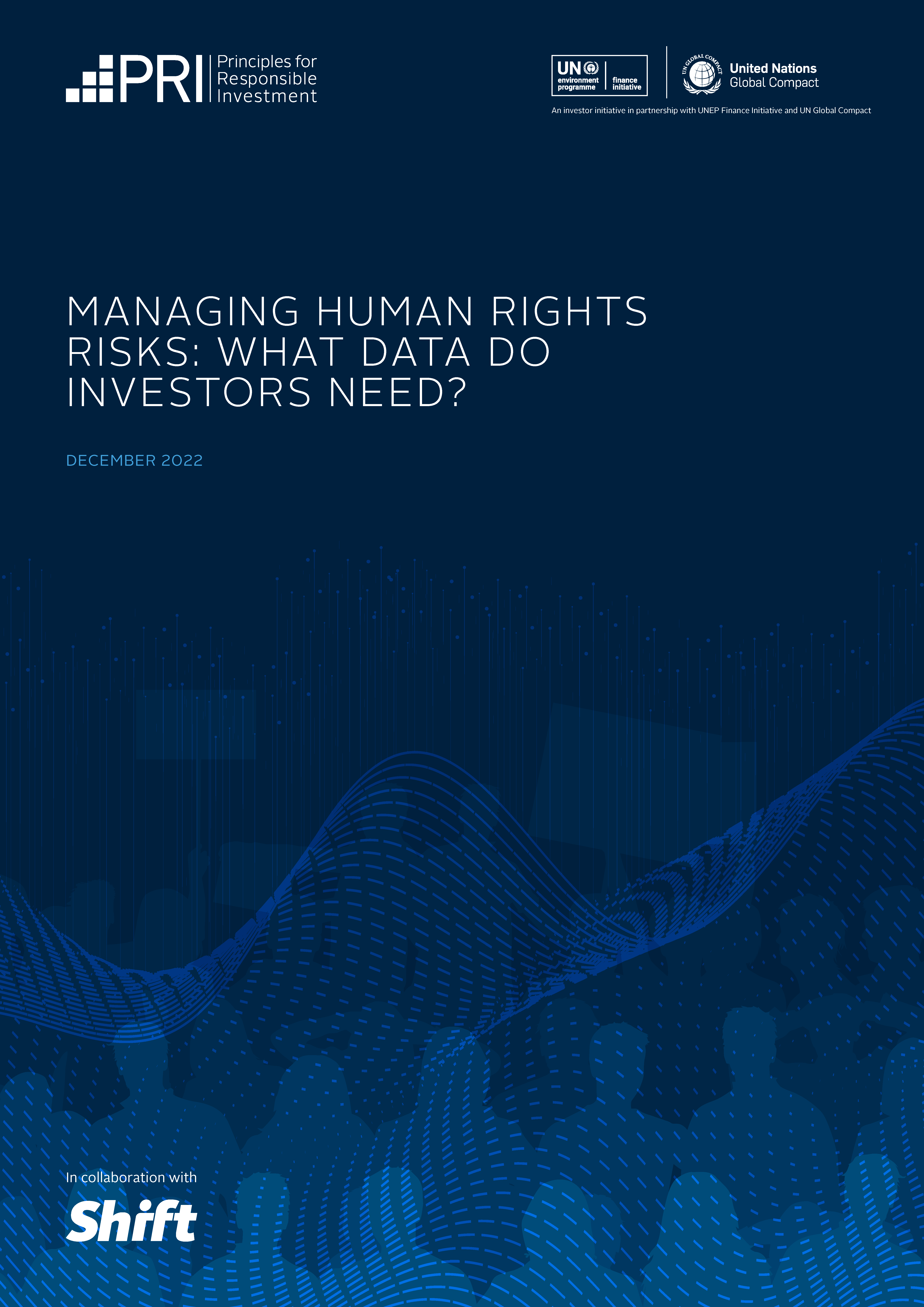
With almost 1 in 4 asset owners using international human rights standards to guide their responsible investment activities last year, investor demand for “better S in ESG” data is growing. Investors are not only considering the impacts on people that arise or could arise from their business activities and investee companies, but they are also trying to understand how risks to people can create financial and reputational risk.
Working together, Shift and UN PRI, the world’s leading proponent of responsible investment, set out to identify the key challenges facing investors in understanding and addressing how portfolio companies manage human rights risks within their operations and value chains. In this paper, they outline four key areas for improving the quantity and quality of information accessible to investors. Download the full report to learn more about how these gaps can be addressed, and how they relate to the latest developments in reporting standards.
Embedding the UN Guiding Principles in Finland’s State Financing of Private Sector Activity Abroad
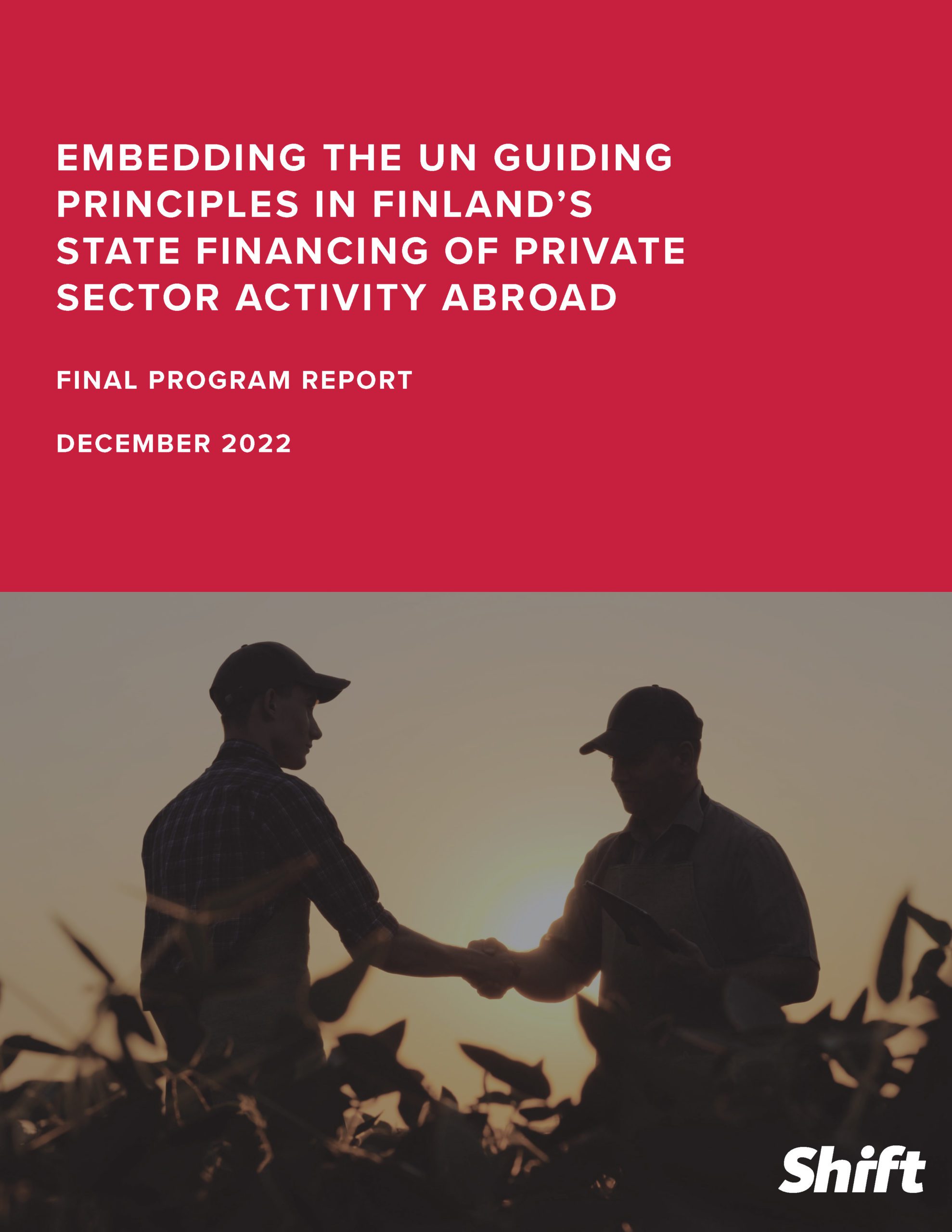
Between 2018-2021, THE FINNISH GOVERNMENT engaged Shift to support a comprehensive approach to integrating the UN Guiding Principles into the work of the main programs and agencies that provide state financing to Finnish businesses investing abroad. This included Finland’s national development finance institution and export credit agency, and several tailored programs, including one focused on private equity.
Shift’s support aimed to strengthen alignment between the policies, processes and practices of these agencies and programs and the expectations of the UNGPs, by embedding a human rights lens in their due diligence approaches. Read the final program report to learn more about the key takeaways – and three tools developed as part of Shift’s wider Valuing Respect Project that can help any financial institution – whether public or private sector – strengthen its human rights efforts.
Enhancing the S in ESG: Tools for Investors and Lenders to Drive Better Evaluation and Engagement on Human Rights
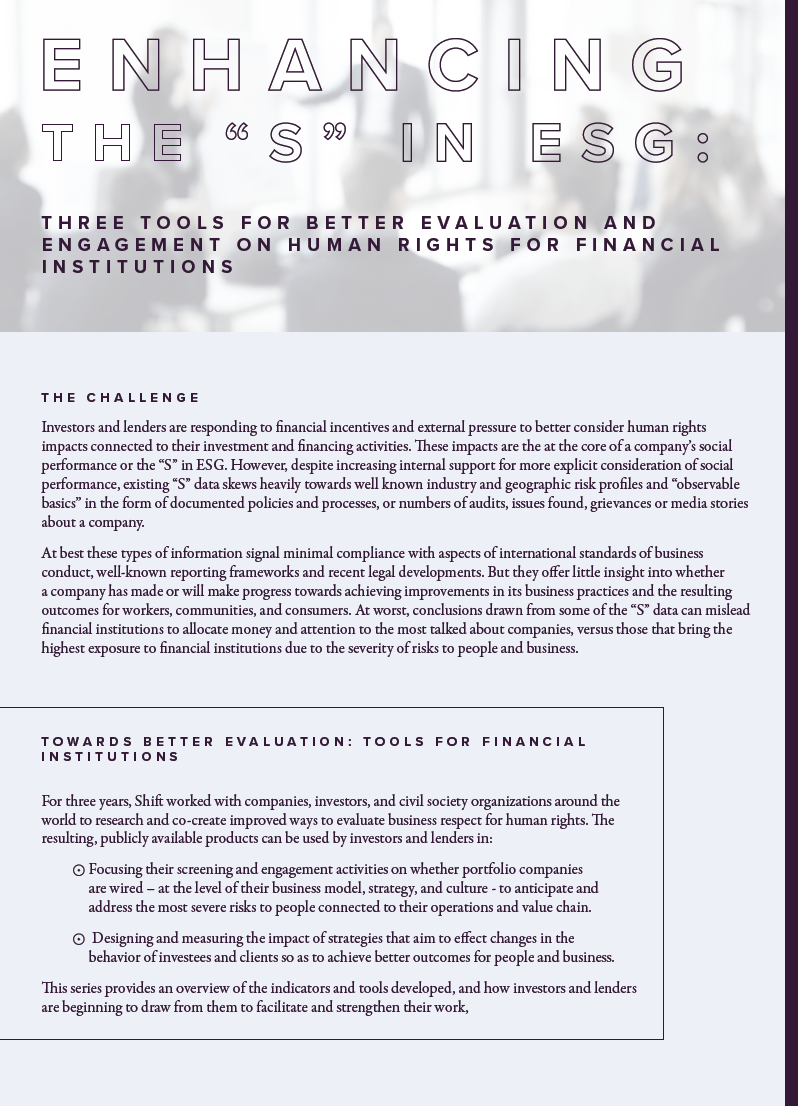
Investors and lenders are responding to financial incentives and external pressure to better consider human rights impacts connected to their investment and financing activities. These impacts are at the core of a company’s social performance or the “S” in ESG. However, despite increasing internal support for more explicit consideration of social performance, existing “S” data skews heavily towards well-known industry and geographic risk profiles and “observable basics” in the form of documented policies and processes, or numbers of audits, issues found, grievances or media stories about a company.
At best these types of information signal minimal compliance with aspects of international standards of business conduct, well-known reporting frameworks and recent legal developments. But they offer little insight into whether a company has made or will make progress towards achieving improvements in its business practices and the resulting outcomes for workers, communities, and consumers. At worst, conclusions drawn from some of the “S” data can mislead financial institutions to allocate money and attention to the most talked about companies, versus those that bring the highest exposure to financial institutions due to the severity of risks to people and business.
For three years, as part of our Valuing Respect Project, Shift worked with companies, investors, and civil society organizations around the world to research and co-create improved ways to evaluate business respect for human rights. The resulting, publicly available products can be used by investors and lenders in:
- Focusing their screening and engagement activities on whether portfolio companies are wired – at the level of their business model, strategy, and culture – to anticipate and address the most severe risks to people connected to their operations and value chain.
- Designing and measuring the impact of strategies that aim to effect changes in the behavior of investees and clients so as to achieve better outcomes for people and business.
This series provides an overview of the indicators and tools developed, and how investors and lenders are beginning to draw from them to facilitate and strengthen their work.
These tools were produced as part of a multi-year program of expert support to the Finnish Government, focused on integrating the UNGPs into the activities of the main state agencies and programs supporting Finnish private sector investment abroad. This work is summarized in the final program report.

Business Model Red Flags
Investors and lenders may be missing a key source of risk in their portfolios, as well as the opportunity for more sophisticated and effective engagement, if they fail to consider how a company’s business model can lead to negative impacts on human rights.
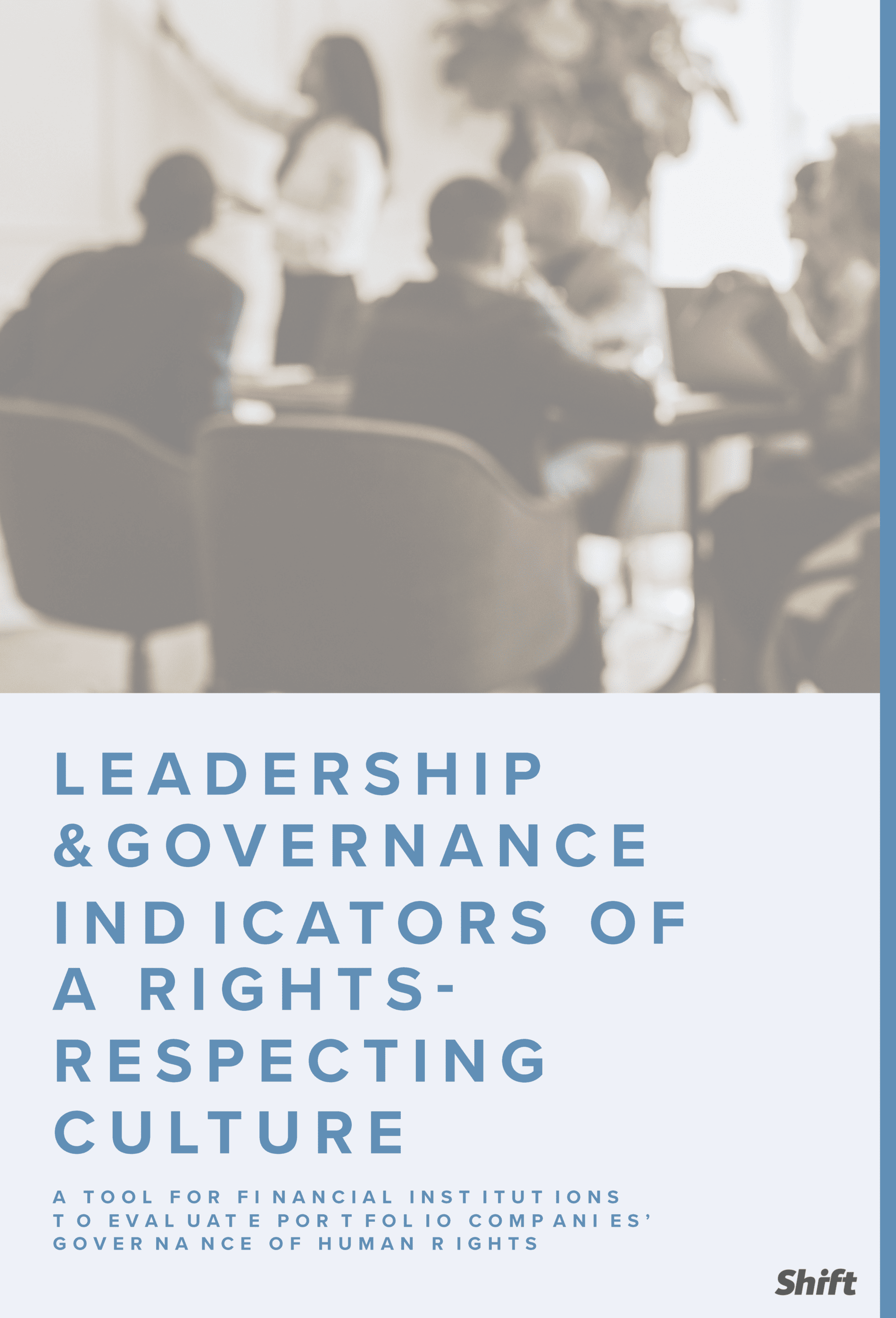
Leadership and Governance Indicators of a Rights Respecting Culture
Lenders and investors that can identify the appropriate leadership and governance characteristics that drive a rights-respecting culture, can better understand and influence the extent to which their portfolio companies think and act about impacts on people. This resource offers an introduction to Shift’s Leadership and Governance Indicators.

Indicator Design Tool – a tool for Financial Institutions
The Indicator Design Tool provides financial institutions with a structured way to design and measure their efforts to use leverage with portfolio companies. At the core of the tool is an approach known as Theory of Change thinking: a well-established practice for designing, monitoring and evaluating interventions.
